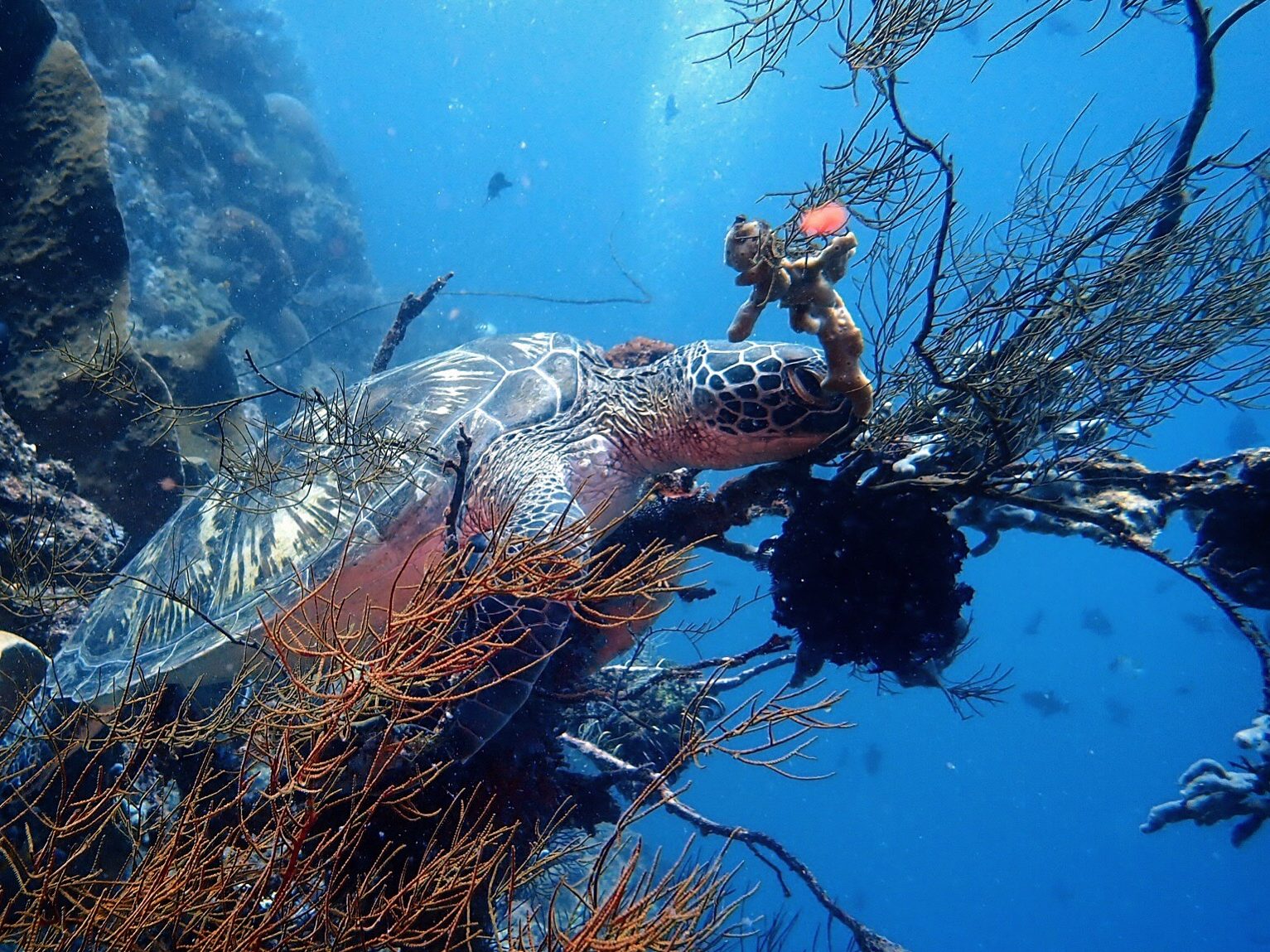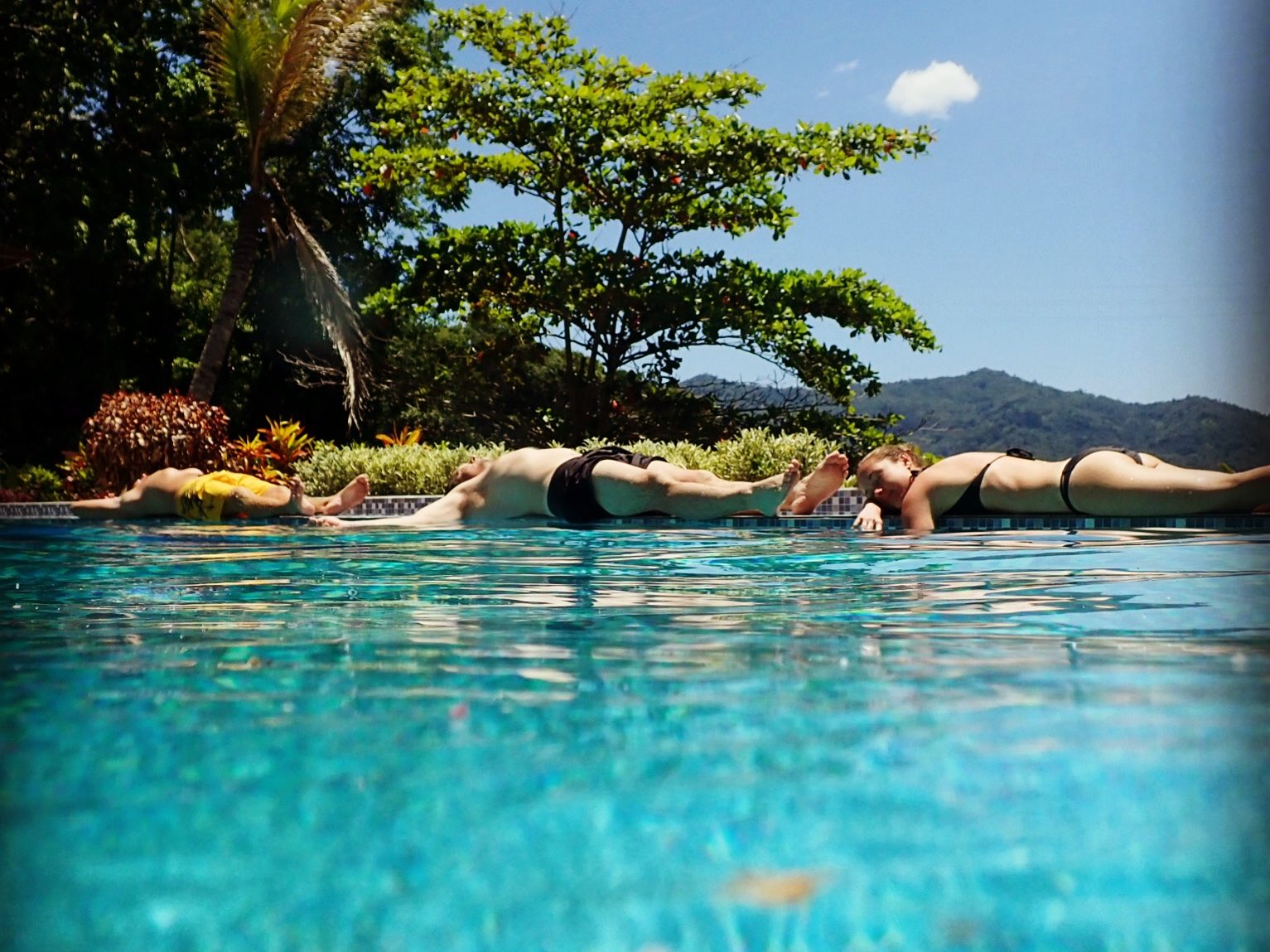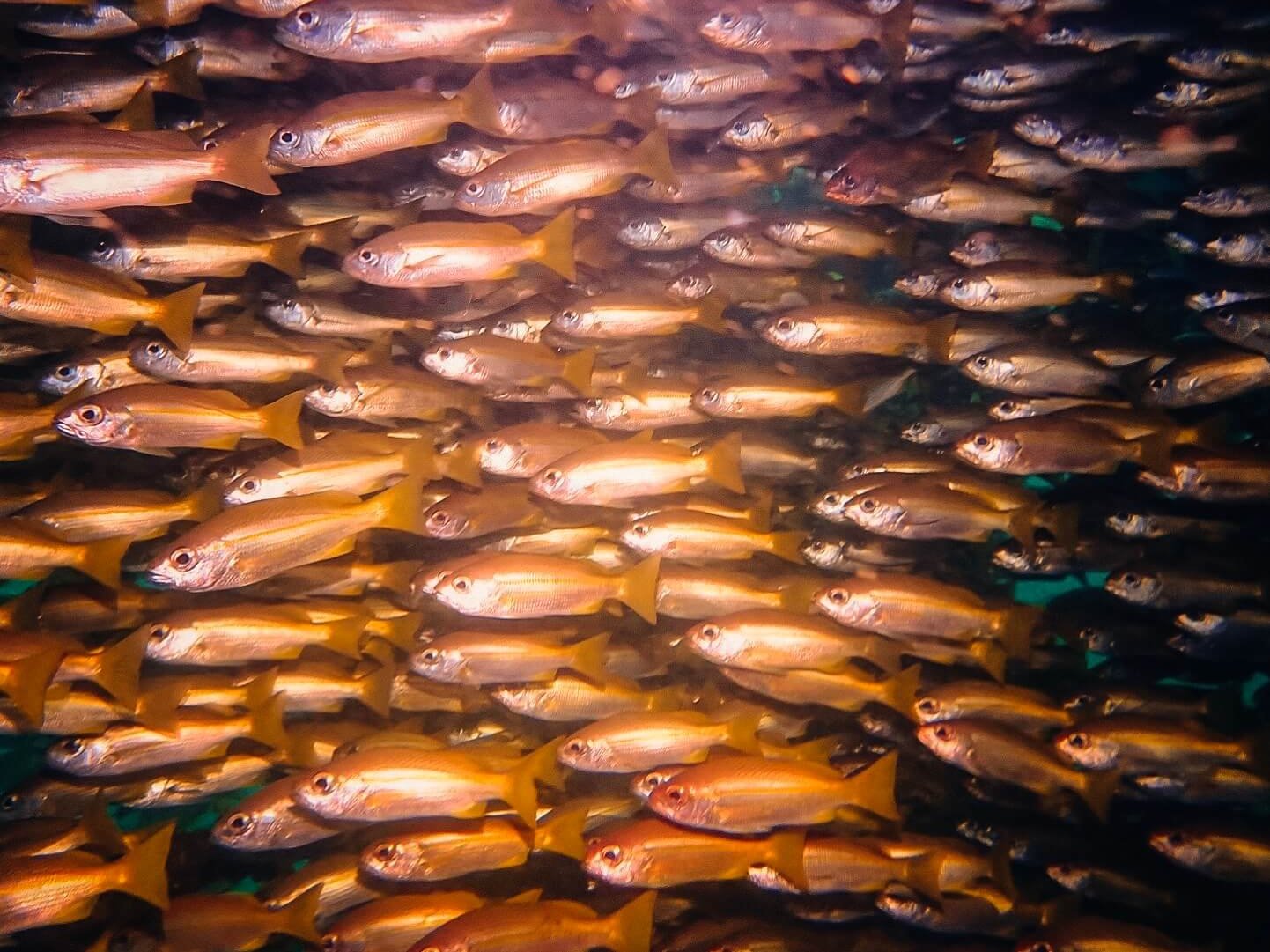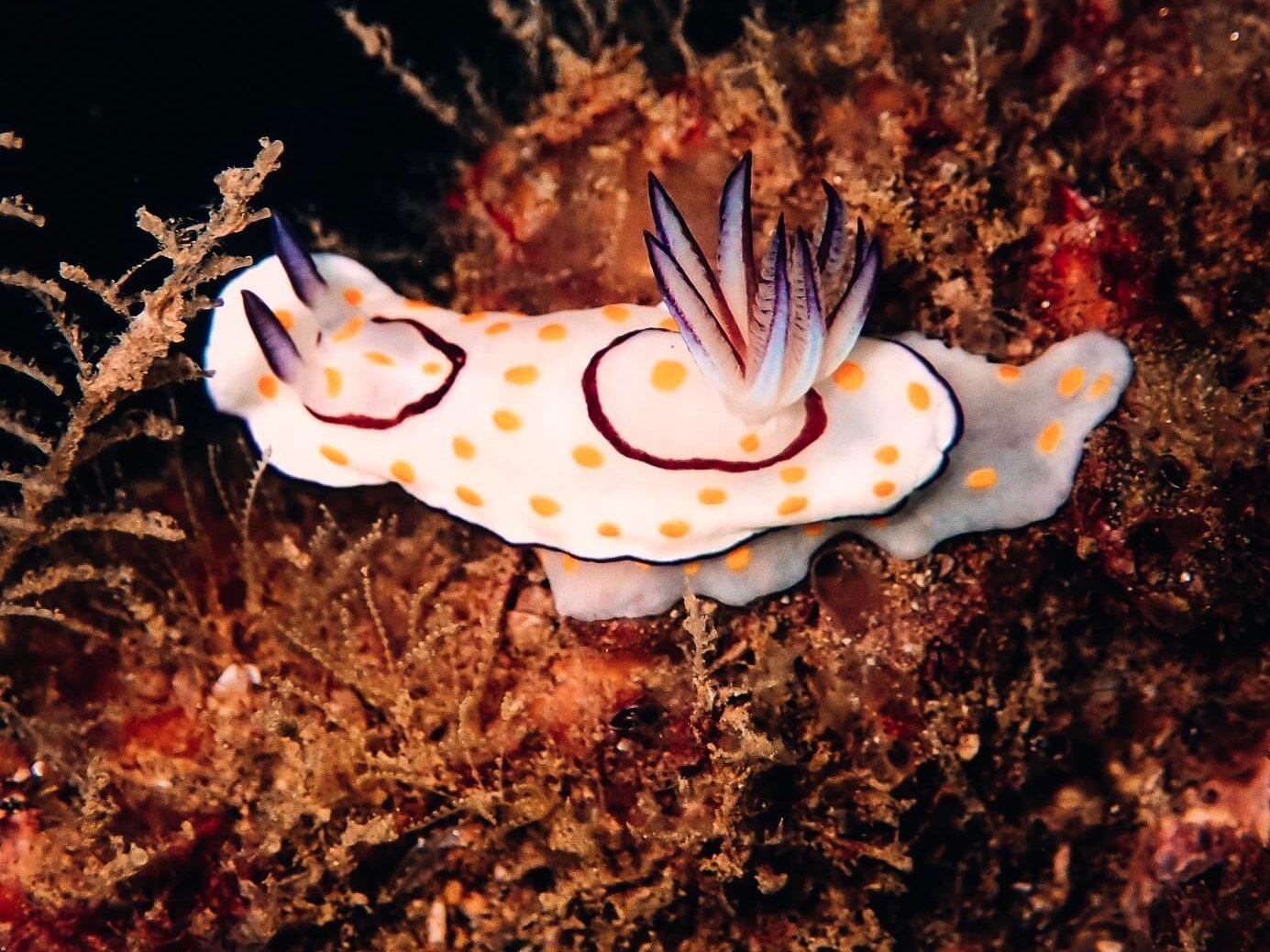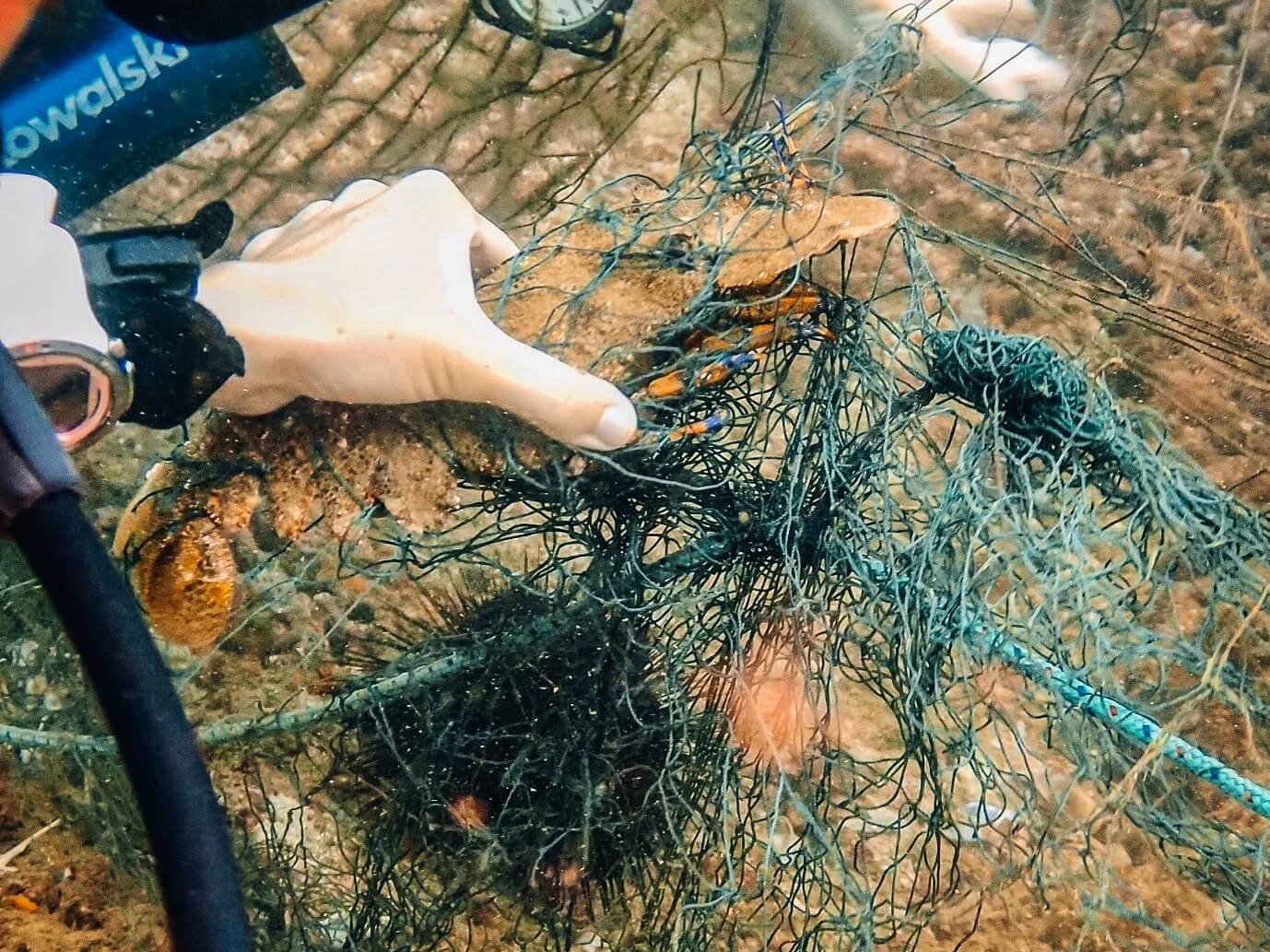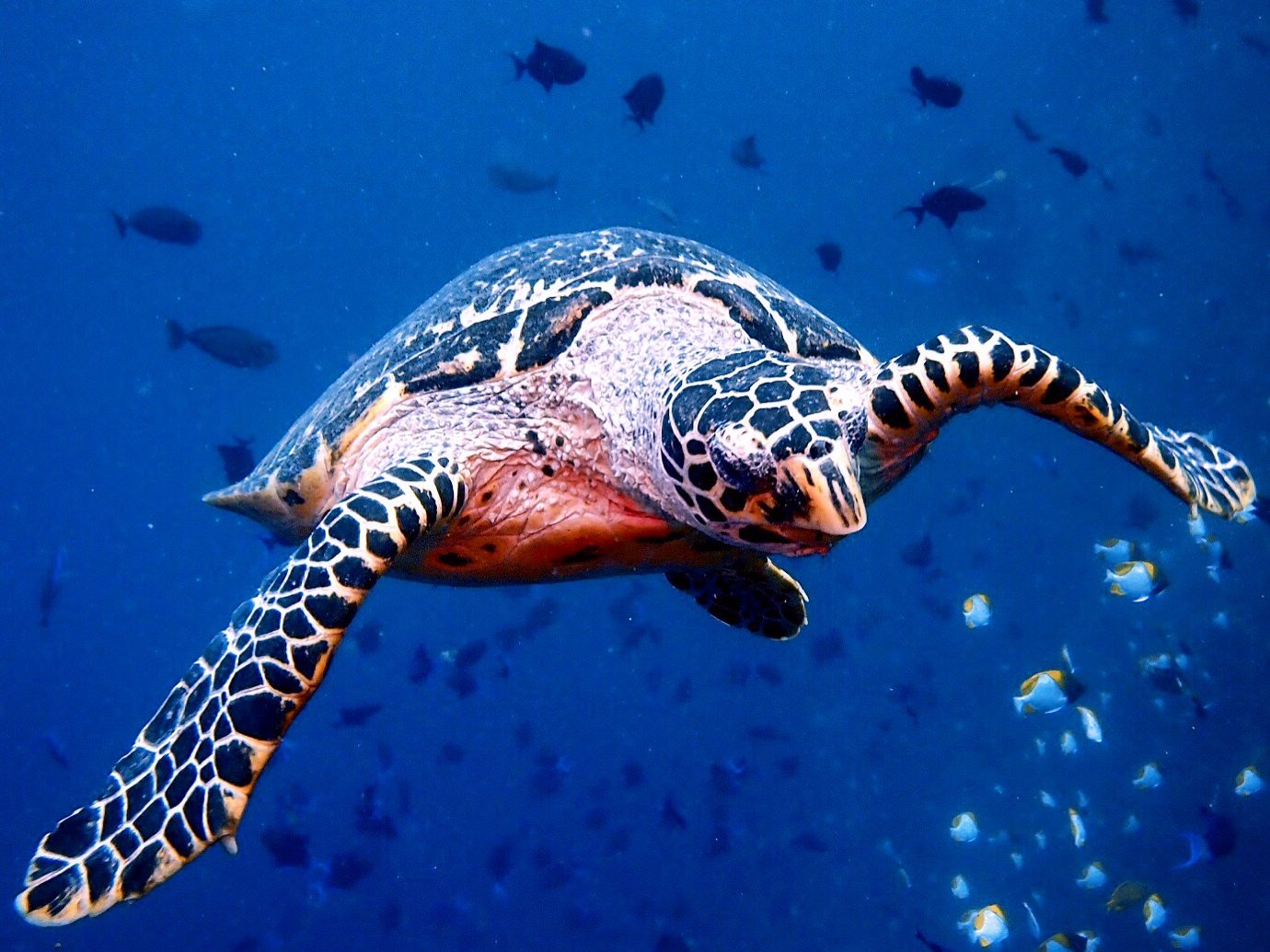
In no time at all, our vacation was half gone and it was our last day of diving in the Bunaken area. For our last day of diving, we requested two of our favorite spots we had been to during the week: Sachiko’s Point and Mandolin. Sachiko’s Point proved that no two dives are ever the same. You simply cannot repeat an experience. There is always something new waiting for you in the ocean. In this case, the plethora of dogtooth tuna that had been cruising the reef previously, were now nowhere to be found.
On to Mandolin for our final dive in Bunaken National Park. The four of us lined up along the edge of the large, wooden boat, gear donned, ready to back-roll into the water as soon as our guide, Alan, gave the count to three. Unfortunately, an unsynchronized chorus of ones and twos and threes chimed in from the boat boys who were all having some fun. I hadn’t figured out how to tell their voices apart yet, and so missed which “three” amongst the many belonged to Alan. Everyone else made it into the water. I was left sitting on the boat’s edge, and of course once you’ve realized you’ve missed, it is important to wait again until everyone else is out of the way. I used the be terrified in Fiji that a hesitant student would roll after the fact and land on top of myself or another diver. Always roll on signal, or wait until it is clear again.
We descended into the blue, on top of the reef, kicked effortlessly to the edge, and then descended down the wall, a steep drop that stretched much, much farther than the eye could see. Immediately, the reef burst into colors, both from fish and from the corals. The reef in Bunaken that whole week had been breathtaking, and full of life. The corals were abundant and healthy. My few attempts at macro shots had mostly been failed due to not having a single space of dead coral or rock on which to steady myself and the camera with a fingertip. No matter. I’d take a healthy reef over a photograph any day.
| Whitemouth Moray (Gymnothorax meleagris) in the midst of a wall of colorful corals. |
The life beyond the wall was equally stunning. Extending several meters out into the blue, were endless schools of fish, in numbers that could make you forget that the oceans are being overfished for a moment. I’ve always loved redtooth triggerfish. They are about the size of teacup saucers, deep blue, with billowing fins that look like little capes caught in the wind, and two red teeth protruding that look like little fangs dripping blood. For this reason, I have always called them vampire fish in my head. All of our dive sites had shown us hundreds of thousands of these little guys, fluttering about like a kaleidoscope of butterflies.
| A kaleidoscope of redtooth triggerfish (Odonus niger) swarms the reef. |
| Despite their numbers, it is surprisingly tricky to get a closeup of one. |
Almost as numerous as the vampire fish were the pyramid butterflyfish, triangles of white in the center giving them their name, with the surrounding corners providing a vibrant yellow to the scenery. Closer to the reef, the occasional blue-girdled angelfish would hide under some coral. I had never seen this species of angelfish before Indonesia. They were about the size of dinner plates, with a bright yellow saddle, chin, and tail fin. The remaining splotches were dark blue, and a barrier of that electric blue that glows underwater separated the yellow from the dark blue, like a ribbon of electricity meandering its way around the fish, making it impossible for it to hide despite its efforts.
| The pyramid butterflyfish (Hemitaurichthys polylepis) were almost as numerous as the redtooth triggerfish. |
| The blue-girdled angelfish may not have been able to hide from view, but they most certainly could hide from the camera. (Pomacanthus navarchus) |
Farther out into the blue, slender unicornfish swam by in schools, another species I had never seen before this trip. They didn’t have the telltale horn that some unicornfish are named for, and were elongated and elegant, with a shape sort of like the Jesus fish outline. A distinguishing white splotch could be seen around the pectoral fins, giving them another color to show off besides the soft grey. Occasionally, a bignose unicornfish would join the crowd, with its detailed, painted face, and crescent tail fin that elongated into ribbons.
| Bignose Unicornfish (Naso vlamingii). You’ll have to forgive some of my fish closeups. They don’t exactly like to stay still long enough to have their photos taken. |
Bunaken was also full of turtles, more turtles than I had seen anywhere else in the world. The seventh turtle we saw that dive proved to be a bit of a special one. We watched him swim towards the reef as if looking for a spot to rest (they were all extremely lazy turtles, and could usually be found sleeping in the coral), only to turn away again and swim once more into the blue. Fletch joked that the turtle had been drinking with a tilt of his hand up to his mouth. Then he opened his arms out wide as if to welcome the turtle over. To provide a little extra encouragement, I started moving my arms in a motion that mimicked the turtle’s flippers. In Fiji, this motion used to get the turtles to slow down, curious as to what was moving the same way they do. Most of the turtles here had just continued to swim past, aloof. This guy swam straight for us though. He came so close to me that he no longer fit within the frame of my camera, in fact he nearly bumped into me, before turning at the last minute to slowly glide past me. Without moving another muscle, I held very still and gingerly stretched out my arm, allowing his shell to graze my hand. It was rougher then I expected. A turtle has never allowed me that closeness before. Please understand that touching and harassing the wildlife is never ok. When you are very calm and it approaches you though, something magical might just happen.
| Hawksbill Sea Turtle swimming over to say hello. |
The eighth turtle also proved to be a special baby. We found him snuggled up behind a bundle of sponge barrels. Our approach startled him enough to get up and leave, as is often the case, only he couldn’t easily fit through the opening in the garden of sponges. Watching him flailing about, trying to wiggle around the right way to fit through was like watching one of those videos of the fat cats trying to fit through the doggy doors. If you haven’t seen those, you should search them on Youtube. It’s a laugh.
There was so much going on in the blue that I hardly looked at the wall all dive, but when I did look back for a moment, it was to find a nudibranch, translucent peach colored with pinpoints of bright orange, about the size of a golf ball, cannon balling down the wall. The four of us discussed this later and decided that sea slugs must do this for fun, because if you’re a sea slug, what else do you do for fun all day besides climb up to a high perch and then jump back down again?
| This was the same type of nudi we saw cannonballing (although not this exact one). (Halgerda batangas.) |
Around the time we were starting to shallow up, we heard the high pitched squeal. I guessed it was dolphins, and turned to see if everyone else had heard them too, or if I was just turning random sounds into wishful thinking. A glance in everyone else’s direction showed all of my dive buddies and our guide similarly hovering around in circles, eyes eagerly scanning the open blue. Someone waved their hand like a dolphin jumping. We abandoned the wall and started swimming into the blue. The squealing grew louder. The farther we swam, the louder it grew, until it was almost ear-piercing. It’s amazing how much sound some animals can make underwater. I ditched all sense of reason and just starting kicking straight out into the blue and towards the sound as hard as I could. It is extremely rare to see dolphins underwater. We see them all the time from the boats, surfing the bow for fun, but they don’t show themselves to divers unless they really want to, and usually they don’t. I’ve never seen dolphins beneath the surface. If I was ever going to, now was the time.
It’s amazing how quickly you lose sense of direction when there is nothing but blue in every direction. No wall for reference. No bottom along which to follow the contour. Just endless expanses of blue. And usually one leg is stronger than the other, so I couldn’t even be sure that I had been kicking in a straight line the whole time. Peeps, don’t ever try that on your dive holiday. I was fully prepared to go up and wait for everyone at the surface when I completed my 360 degree rotation and realized that the rest of the group was still well within my field of view. Then Alan pointed eagerly straight ahead; he saw them. I kicked back in that direction and there they were, just close enough to see the outlines of four or five distinct cetaceans, just far enough away to let us know that we wouldn’t bet getting any closer. And then there was another pod of half a dozen of them to the left, and another pod to the right, all just far enough away to make the camera useless. All just close enough to make my heart skip a beat. We kicked as hard as we could, following one pod, which would eventually fade into the blueness, only to be replaced by another pod, which we would try to follow in another direction. They never let us get any closer, but they had us surrounded and awed. At one point I was so entranced that I nearly spat my regulator out of my mouth. It suddenly felt unnatural and in the way. In all my years of diving I have never felt the need to do something so senseless, not even as an open water student, way back when. Luckily I caught myself before I had to find it again, reminding myself that I was not a dolphin. I needed that air if I wanted to keep swimming. How inconvenient.
| Dolphins, just close enough to tease us. |
The dolphins eventually had their fun and retreated beyond our view. We made our way back to the wall, somehow visible again; we must’ve swam a giant circle out in the blue. All the while the squealing noise was growing louder again, teasing us, like a siren’s song.
Back on the boat the dolphins graced us with a final, bow-surfing show. Only now from the surface could we see just how numerous they were. Pods of half a dozen each, were peppered across the water in every direction, making up a group of hundreds of dolphins playing in the water, racing alongside the boat, trying to get ahead just long enough to leap out of the water in a dazzling show, and then fall back in line to allow a second to take its place. The four of us, and all the Indonesian boys, and all the Swiss-French guests, whooped and hollered and cheered them on. There’s nothing like a beautiful show of nature to break down language barriers. By the time we finally waved goodbye to the dolphins and made our way back to the resort in Manado for the final time, my cheeks were hurting from smiling so much. Thank you for the epic send-off, Bunaken.


